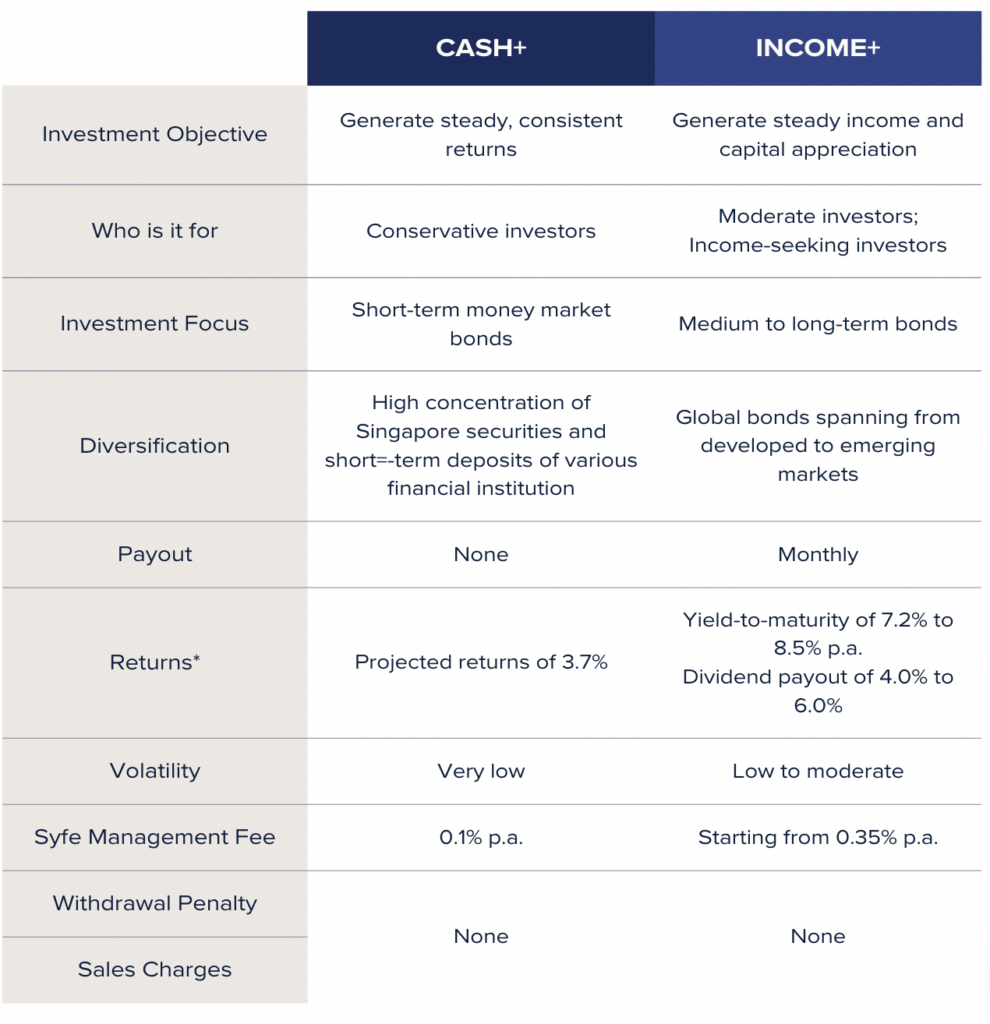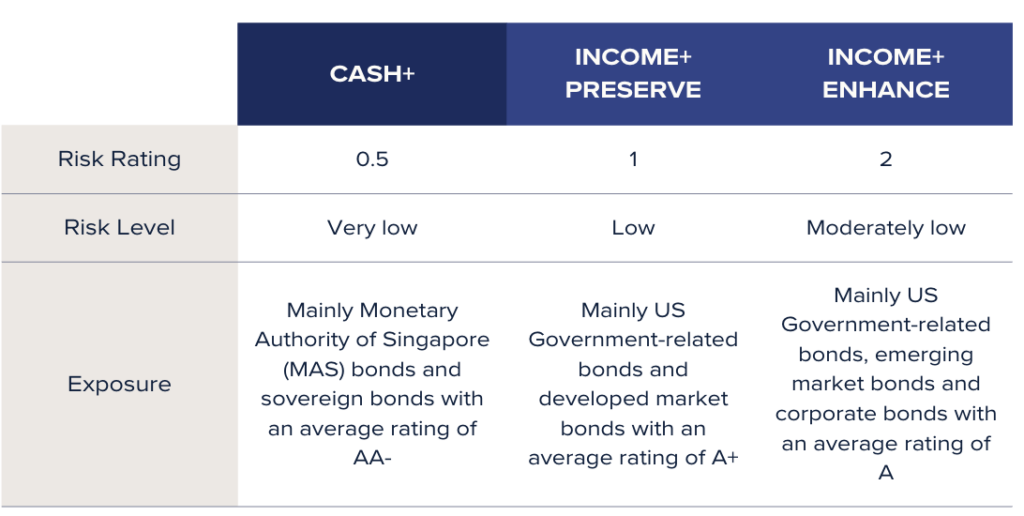
Income+ has quickly grown to be one of Syfe’s most popular portfolios on the platform since the launch in April 2023.
As both Cash+ and Income+ are rated with lower risk ratings compared to equities or REITs focused portfolios, one of the most frequently asked questions since Income+ launch was around differences between the two, given its similarities in fixed income active fund composition and specs to the portfolio.
In this article, we will unpack the key similarities and differences of the two portfolios and potential use cases for you as an investor.

Note: *Returns refer to broader investment outcomes. Calculations may vary according to product. Figures are updated as of the latest as of the published date. See individual portfolio pages for updated figures.
Understanding Underlying Funds
Cash+ is constructed using money market funds from Lion Global Investors, an asset manager part of the OCBC Group. The underlying assets consist of short-term money market instruments and low-risk debt securities ranging from deposits and government bonds to high quality corporate bonds with a significant portion of holdings based in Singapore.
Income+ powered by PIMCO is built with global fixed income funds. PIMCO is globally recognised for its expertise in fixed-income investments and has a long-standing track record in managing global bond funds. The underlying assets encompass a diverse range of medium-term and low- to moderate-risk fixed income securities spanning from US Government, corporate bonds and mortgage-backed securities to emerging market bonds.
The money market is part of the fixed income broader investment asset class. Money market funds specialise in short-term debt securities with lower tenors (typically less than a year) as compared to an average fixed income fund. Hence, Cash+ has a lower risk rating than Income+ with slightly lower projected returns per annum.
Potential Returns: Projected Return VS Monthly Payout
Cash+ portfolio returns are accumulative in nature where interest from the underlying bonds are automatically reinvested within the constituent money market funds to grow the value of the portfolio. It is designed for investors to achieve a return in SGD that is higher than the prevailing money market rates and savings accounts in Singapore. The current projected return of Cash+ is 3.6% p.a.
Income+ portfolio total returns comprise of both monthly dividend payouts and potential capital appreciation of its underlying bond holdings. The monthly payout ranges between 4-6% p.a., while the overall total yield of the portfolio ranges between 6.7% (Preserve) to 8.4% p.a. (Enhance).
Global vs Local
The other key difference is exposure to local vs global markets. While Singapore as a home market to many may be considered as a ‘safer’, closer to home option, however, diversifying into global fixed income may present an investor with greater return opportunity from larger and emerging economies of the world.
Which is safer? Income+ or Cash+?
On a relative basis, Income+ portfolios carry a higher level of risk compared to the Cash+ portfolio due to their composition of longer duration bonds (4-5 years) and slightly lower credit profiles (A/A+). The Income+ bond funds are subject to fluctuations in interest rates, which can impact the value of the underlying bonds in the short term. Between the Preserve and Enhance portfolios, the Preserve portfolio encompasses more capital preservation elements with a focus on investment grade quality bonds vs the Enhance portfolio focuses on higher yield with expanded exposure to high yield and emerging market bonds.
On the other hand, the Cash+ portfolio consists of low-risk money market funds. This portfolio prioritises the preservation of capital and aims to maintain a stable principal value, offering a more secure investment option.

Speaking from a risk, returns and investment horizon basis. If you are looking to see your savings grow steadily and generate returns better than short-term deposits, the Cash+ portfolio is an appealing option. Or if you’re just getting started and would not like to see fluctuations in your portfolio this might be a good option. Since inception, Cash+ has not had a negative return month. If you seek regular income and potential to appreciate capital over the longer term, Income+ might be a better option for you. Income+ generates regular monthly dividend payouts that can serve as supplemental or retirement income for investors. While the value of the portfolio may fluctuate in the short term due to market movements, the potential capital appreciation compensates investors for the added risk.
Which one is better for me? Income+ or Cash+?

Cash+ is specifically built for investors looking to park their excess cash and earn higher projected returns than bank deposits. Cash+ returns are steady and consistent due to the high quality and lower duration nature of the underlying money market instruments which are typically held to maturity.
Income+, on the other hand, is built for investors looking to generate a regular stream of income over a longer-time horizon compared to Cash+. Income+ investors enjoy monthly payouts from the dividends of a diversified pool of global bonds. Income+ portfolio is more sensitive to changes in interest rates since the duration of the underlying bonds is comparatively longer. However, over a longer term, Income+ rewards investors with the potential of capital appreciation of the underlying bonds which enhances the total return of the portfolio.
Other consideration factors that you can consider would be how you would need to use this money. Cash+ fund transfers are typically within the next business day. Making the portfolio very liquid for those who might want to withdraw or use it for emergency funds or shorter term needs.
Income+ on the other hand will payout dividends on a monthly basis, so if you’re looking for passive income, want to use dividends towards an expense, it could be convenient for you as it pays out directly to your bank account.
Cash+ and Income+ Aren’t Mutually Exclusive

You don’t have to pick one or the other. You can have both portfolios for differing objectives depending on your financial needs. For example, you can put your emergency funds into Cash+ to earn steady returns which are higher than your regular bank deposit savings, but also have investments in Income+ to compliment your passive income stream you’re working towards your retirement.
Ultimately, your decision should be based on your specific needs, goals, and timeframe.



You must be logged in to post a comment.